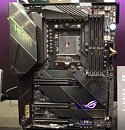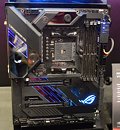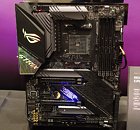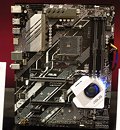- Joined
- Oct 9, 2007
- Messages
- 47,533 (7.48/day)
- Location
- Hyderabad, India
| System Name | RBMK-1000 |
|---|---|
| Processor | AMD Ryzen 7 5700G |
| Motherboard | ASUS ROG Strix B450-E Gaming |
| Cooling | DeepCool Gammax L240 V2 |
| Memory | 2x 8GB G.Skill Sniper X |
| Video Card(s) | Palit GeForce RTX 2080 SUPER GameRock |
| Storage | Western Digital Black NVMe 512GB |
| Display(s) | BenQ 1440p 60 Hz 27-inch |
| Case | Corsair Carbide 100R |
| Audio Device(s) | ASUS SupremeFX S1220A |
| Power Supply | Cooler Master MWE Gold 650W |
| Mouse | ASUS ROG Strix Impact |
| Keyboard | Gamdias Hermes E2 |
| Software | Windows 11 Pro |
A reliable source based in Taiwan shared with us the price-list of upcoming AMD Ryzen 3000 X570 chipset motherboards by leading manufacturer ASUS. These MSRP prices in U.S. Dollars paint a grim picture of these boards being significantly pricier than previous-generation motherboards based on the AMD X470 chipset. We already got hints of AMD X570 motherboards being pricey when MSI CEO Charles Chiang, who is known for not mincing his words in public, made it clear that the industry is no longer seeing AMD as a value-alternative second-fiddle brand to Intel, and that AMD will use its performance leadership to command premium pricing for these motherboards, even though across generations, pricing of AMD processors are going to remain flat. The Ryzen 7 3700X, for example, is launching at exactly the same $329 launch price as the Ryzen 7 2700X.
Even MSI CEO Chiang's statement couldn't prepare us for the prices we're seeing for the ASUS motherboard lineup. The cheapest AMD X570 motherboard from ASUS is the Prime X570-P, which is priced at USD $159.99. Its slightly bolstered twin, the TUF Gaming X570-Plus will go for $169.99. A variant of this exact board with integrated Wi-Fi 6 will be priced at $184.99. This is where things get crazy. The Prime X570-Pro, which is the spiritual-successor of the $150 Prime X470-Pro, will command a whopping $249.99 price-tag, or a $100 (66 percent) increase! The cheapest ROG (Republic of Gamers) product, the ROG Strix X570-F Gaming, will ship with an HEDT-like $299.99 price. This is where the supposed "high-end" segment begins.




The ROG Strix X570-E Gaming is a slightly spruced-up Strix-F, with a handful more connectivity options, and an extra M.2 slot. This board will be priced at $329.99. And we're still with the "tier-two" ROG Strix family. The ROG Crosshair VIII Hero is what you'd want for the premium ROG experience, and a premium CPU VRM solution. This board is priced at $359.99, over $100 more than the Crosshair VII Hero. Need Wi-Fi? Pull out another Jackson for the $379.99 ROG Crosshair VIII Hero Wi-Fi, which comes with 802.11ax WLAN.
Record-seeking OC wizards who want to push the Ryzen 9-series processors, such as the $749 Ryzen 9 3950X to their limits, will have to spend almost the same amount of money on the motherboard, with the ROG Crosshair VIII Formula, which at $699.99, is pricier than even certain ROG Rampage Extreme products from Intel's HEDT platform. In all, AMD, like any for-profit company on the planet, wants to monetize its performance-leadership over Intel to the fullest.
The reasons for these price increases could be many, besides AMD simply wanting to turn its performance leadership into cash. For one, the AMD X570 chipset is a big and hot (~15W TDP) piece of silicon AMD designed in-house, with a large PCI-Express gen 4.0 switching fabric, and more downstream connectivity than the ASMedia-sourced X470 "Promontory." This chipset needs a much more capable cooling solution than what the X470 needed, including in many cases, an active fan-heatsink. AMD has also dialed up the electrical and physical requirements, with a stronger CPU VRM specification, possibly more than four PCB layers for improved memory wiring, and external PCI-Express gen 4.0 re-driver and lane segmentation components that could be expensive on account of being new.
To most PC buyers, though, there are alternatives within AMD. As we mentioned earlier, processor pricing over generations hasn't increased. The 3700X is priced on par with the launch price of the 2700X it succeeds, and the Ryzen 5 3600 is being launched at the same $199 as the Ryzen 5 2600. You can very much do pair these processors with motherboards based on the older AMD X470 and B450 chipset motherboards, which are stocked up plenty in the market, are priced reasonably, and a majority of models support the USB BIOS Flashback feature, letting you update their UEFI firmware to the latest versions that add 3rd generation Ryzen support, without needing to borrow an older Ryzen chip from a friend. You lose out on PCI-Express gen 4.0 and additional M.2 slots, but that's a compromise you'll have to make. Consider the low-power 400-series chipsets not needing fan-heatsinks to be a sweetener.
View at TechPowerUp Main Site
Even MSI CEO Chiang's statement couldn't prepare us for the prices we're seeing for the ASUS motherboard lineup. The cheapest AMD X570 motherboard from ASUS is the Prime X570-P, which is priced at USD $159.99. Its slightly bolstered twin, the TUF Gaming X570-Plus will go for $169.99. A variant of this exact board with integrated Wi-Fi 6 will be priced at $184.99. This is where things get crazy. The Prime X570-Pro, which is the spiritual-successor of the $150 Prime X470-Pro, will command a whopping $249.99 price-tag, or a $100 (66 percent) increase! The cheapest ROG (Republic of Gamers) product, the ROG Strix X570-F Gaming, will ship with an HEDT-like $299.99 price. This is where the supposed "high-end" segment begins.




The ROG Strix X570-E Gaming is a slightly spruced-up Strix-F, with a handful more connectivity options, and an extra M.2 slot. This board will be priced at $329.99. And we're still with the "tier-two" ROG Strix family. The ROG Crosshair VIII Hero is what you'd want for the premium ROG experience, and a premium CPU VRM solution. This board is priced at $359.99, over $100 more than the Crosshair VII Hero. Need Wi-Fi? Pull out another Jackson for the $379.99 ROG Crosshair VIII Hero Wi-Fi, which comes with 802.11ax WLAN.
Record-seeking OC wizards who want to push the Ryzen 9-series processors, such as the $749 Ryzen 9 3950X to their limits, will have to spend almost the same amount of money on the motherboard, with the ROG Crosshair VIII Formula, which at $699.99, is pricier than even certain ROG Rampage Extreme products from Intel's HEDT platform. In all, AMD, like any for-profit company on the planet, wants to monetize its performance-leadership over Intel to the fullest.
The reasons for these price increases could be many, besides AMD simply wanting to turn its performance leadership into cash. For one, the AMD X570 chipset is a big and hot (~15W TDP) piece of silicon AMD designed in-house, with a large PCI-Express gen 4.0 switching fabric, and more downstream connectivity than the ASMedia-sourced X470 "Promontory." This chipset needs a much more capable cooling solution than what the X470 needed, including in many cases, an active fan-heatsink. AMD has also dialed up the electrical and physical requirements, with a stronger CPU VRM specification, possibly more than four PCB layers for improved memory wiring, and external PCI-Express gen 4.0 re-driver and lane segmentation components that could be expensive on account of being new.
To most PC buyers, though, there are alternatives within AMD. As we mentioned earlier, processor pricing over generations hasn't increased. The 3700X is priced on par with the launch price of the 2700X it succeeds, and the Ryzen 5 3600 is being launched at the same $199 as the Ryzen 5 2600. You can very much do pair these processors with motherboards based on the older AMD X470 and B450 chipset motherboards, which are stocked up plenty in the market, are priced reasonably, and a majority of models support the USB BIOS Flashback feature, letting you update their UEFI firmware to the latest versions that add 3rd generation Ryzen support, without needing to borrow an older Ryzen chip from a friend. You lose out on PCI-Express gen 4.0 and additional M.2 slots, but that's a compromise you'll have to make. Consider the low-power 400-series chipsets not needing fan-heatsinks to be a sweetener.
View at TechPowerUp Main Site









